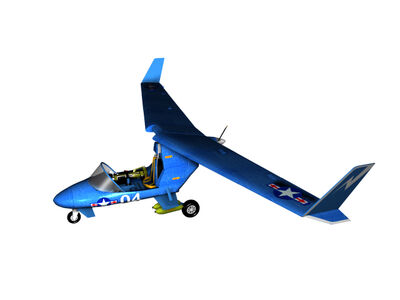
Skyhawk Mk. 1 image by Lee & Noel Hammond
The Skyhawk is the principal attack and reconnaissance aircraft used by the Amtrak Federation. Skyhawks are based on Federation wagon-trains and also at frontier way-stations and some divisional bases. The Mutes refer to them as arrowheads.
Operational history[]
The first Federation aircraft were primitive powered gliders built and developed immediately following the Break-Out of 2465. Over the following centuries microlite aircraft were developed, building up to the first prop-driven Skyhawk Mark 1, which entered service in the early 30th Century. In 2989 the Skyhawk Mk. 2, a considerably more advanced aircraft, entered service, along with the Sky-Rider, which is a variant of the same airframe.
Construction[]
The first Skyhawk Mk. 1s were built at Reagan/Lubbock, which is where the principal Skyhawk production line remains located.
Skyhawk Mk. 1[]
The Skyhawk Mk. 1 was the designation given to the Federation's primary attack aircraft over a century ago, and the design, although much refined, still bears strong similarities to those early aircraft.
The Mk. 1 is an ultralite aircraft consisting of an enormous delta-shaped wing which supports a cockpit module sitting underneath it. The cockpit is open to the elements, as the Mk. 1 is not meant to operate at extreme range from base or a wagon-train, and is susceptible to heavy winds. The huge wing gives the aircraft excellent glide characteristics, meaning that the electric motor can be switched off to conserve power and also hide the aircraft's approach from ground targets. The motor powers a large propeller which is located to the rear of the cockpit and is used mostly for take-off and climbing. The wings are covered with solar cells to allow recharging of the motor. The undercarriage is non-retractable.
The cockpit contains a standard Trail-Blazer triple-barrelled rifle sitting on a 'floating arm' attachment directly above the pilot's head. Small, stubby wings on either side of the cockpit can be fitted with bombs or 5-litre napalm canisters which can be used for bombing runs. Remaining ordinance is typically jettisoned prior to landing runs to avoid the risk of an accident.
The Skyhawk Mk. 1's wings can be folded for storage within the wagon-train. 'Buddy-frames' can be attached to Skyhawk wings to carry additional personnel, although no more than two can be added before the aircraft becomes unflyable.
The Skyhawk Mk. 1 was a mainstay of Federation armament for many years during the war with the Southern Mutes, but during the Battle of the Now and Then River between the Lady from Louisiana and its air wing against the Plainfolk M'Call clan, numerous weaknesses were exposed in the design against this new foe. In particular, the open, unarmoured cockpit meant taking off under fire was extremely dangerous and the light design of the aircraft proved susceptible to Mute crossbow bolts and also to winds and storms conjured up by Mute magic. With the Plainfolk proving a tougher nut to crack than expected, the necessity for a new aircraft was made clear.
Skyhawk Mk. 2[]

Skyhawk Mk. 2 front and bottom elevation from Dark Visions. Image by Pierre-Andre Tilley.
The Skyhawk Mk. 2 had been under development and testing for many years prior to the Battle of the Now and Then River. It was deployed to the Federation wagon-train fleet, starting with the Lady and Red River, in late 2989. Its superior capabilities in combat has seen it become the new mainstay of the Federation air fleet.
The Mk. 2 is a closed-cockpit design with considerably more advanced instrumentation and avionics than the Mk. 1. It is a powered aircraft which is not meant to glide except during an emergency landing. The wingspan is much shorter, but the aircraft itself is longer, with a retractable undercarriage. The aircraft has tougher armour than the Mk. 1 and a built-in six-barrelled electric gun (code-named 'Thor') controlled from the cockpit, which is more efficient and easier for the pilot to operate. Unlike the Mk. 1, the Mk. 2 is reliant on fuel for continued operation. Its range is impressive, clocking in at around 500-600 miles, and unlike the Mk. 1 the closed cockpit and powered engine means it is not as susceptible to weather and the elements.
Although undeniably superior, the Mk. 2 is still susceptible to Mute crossbow fire at low altitudes (albeit at a lower altitude than the Mk. 1) and its inferior glide abilities mean that it isn't as stealthy, since it can fly unpowered only for a much shorter period of time.